Editor's note: The Museum of Photographic Arts
provided source material to Resource Library for the following article
or essay. If you have questions or comments regarding the source material,
please contact the Museum of Photographic Arts directly through either this
phone number or web address:
Edward Steichen: The Early
Years
January 31 through May 17, 2009
The Museum of Photographic
Arts (MoPA) in Balboa Park is pleased to present Edward Steichen: The
Early Years, on view January 31 - May 17, 2009.  Edward Steichen (1879-1973) was one of the most influential
figures in the history of photography. MoPA celebrates this amazing talent
by exhibiting thirteen images made between 1900 and 1925, several of them
made when the photographer was still in his twenties. These early photographs
caught the attention of photographer-impresario Alfred Stieglitz and the
praise of sculptor, Auguste Rodin. (right: Edward Steichen, Grand
Prix at Longchamp: After the Races, Paris, 1907, photogravure, collection
Museum of Photographic Arts)
Edward Steichen (1879-1973) was one of the most influential
figures in the history of photography. MoPA celebrates this amazing talent
by exhibiting thirteen images made between 1900 and 1925, several of them
made when the photographer was still in his twenties. These early photographs
caught the attention of photographer-impresario Alfred Stieglitz and the
praise of sculptor, Auguste Rodin. (right: Edward Steichen, Grand
Prix at Longchamp: After the Races, Paris, 1907, photogravure, collection
Museum of Photographic Arts)
The Early Years, presented
in MoPA's Atrium gallery, is from a 1981 Aperture portfolio from MoPA's
permanent collection consisting of Steichen's signature soft-focus, moody
studies of light, landscape, and form. Steichen's beautifully toned landscapes,
sensual nudes and still life's, and psychological portraits are a dazzling
visual record of his emergence as a major talent. Included in the exhibition
is his famous 1905 twilight view of New York's Flatiron Building
(one of the landmarks of turn-of-the-century architecture), his 1904 Moonrise
(Mamaroneck, NY), and his little known In Memoriam, a nude
from 1902 (inspired perhaps by his friendship with Rodin).
Steichen heavily influenced photography, graphic design,
and the decorative arts in the 1920s and 1930s. He captured the energy and
innovation of his day, working as he did with "a designer's eye, a
poet's sensibility, and an entrepreneur's charisma," wrote Steichen
scholar Joel Smith. Steichen made his mark with a stunningly beautiful array
of quiet Pictorialist photographs that Stieglitz championed in his first
issues of Camera Work, images that today have broken all photography
auction sales records. He would later become a major fashion photographer
for the leading magazines of his era, a highly sought after portraitist
in Europe and America, a war photographer in two World Wars, and a groundbreaking
curator at the Museum of Modern Art, NY. MoPA's The Early Years is
testimony to Steichen's emergence as a formidable artist and tastemaker
who would profoundly shape the world of photography for the next four decades.
Running concurrently at MoPA is Lou Stoumen: The Naked
Truth on view January 31 - May 17, 2009, Lou Stoumen Award
Winners: The Legacy featuring the Mikhael Subotzky, the new Stoumen
Prize winner, and all past recipients on view January 31 - May 10, 2009
and Considering Edward Curtis on view February 7 - May 10, 2009.
Also on view, Picturing the Process: Exploring the Art & Science
of Photography from February 7- July 25, 2009.
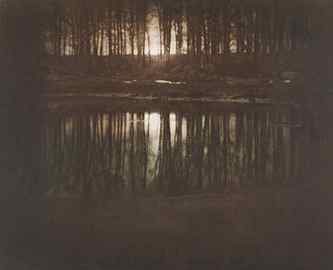
(above: Edward Steichen, Moonrise, Mamaroneck, New York,
1904, photogravure, collection Museum of Photographic Arts. © Joanna
T. Steichen)
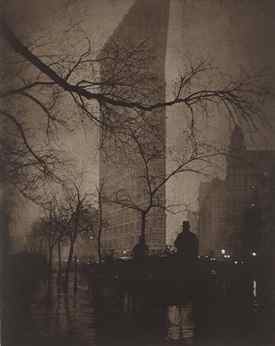
(above: Edward Steichen, The Flatiron Building, New York,
1905, photogravure, collection Museum of Photographic Arts. © Joanna
T. Steichen)
Wall text for the exhibition
- One of the most influential figures in the history of
photography, Edward Steichen (1879-1973) was also one of the most prolific
and diverse. No other photographer can claim a leading role among the Photo-Secessionists,
vibrant innovation in fashion photography, chief photographer for Condé
Nast's Vogue and Vanity Fair, war photography born of two
world wars, signature celebrity portraiture, and the title of curator at
MOMA/NY where he conceived the groundbreaking exhibition, The Family
of Man, viewed by nine million people in thirty-eight countries.
-
- Born in Luxembourg and raised in Wisconsin, Steichen
started out as a painter while in his teens, and later learned photography.
By age twenty-three he was creating painterly landscape photographs, moody
still life's, and lush nude studies that caught the attention of famed
sculptor Auguste Rodin and the impresario of art photography, Alfred Stieglitz.
Over the next two decades, the young Steichen -- the most 'in-demand' portraitist
of the elite on two continents -- became the peerless master of the painterly
photograph. As Steichen scholar, Joel Smith, notes, "He worked with
a designer's inventive eye, a Symbolist's poetic sensibility, an entrepreneur's
charisma, and, above all, the originality and finesse of a creative, painstaking
printer to establish ambitious new standards in artistic photography."
-
* * *
-
- Edward Steichen: The Early Years
presents the photographer's work from 1900 to 1925, his most creative decades.
Within those years, he made his famous twilight view of New York's Flatiron
Building. A landmark of turn-of-the-century architecture, Steichen transforms
this symbol of a new age into a mirage that floats behind a Japonisme
masterpiece of blackened branches and hansom cabs. Conversely, the negative
space carved by the Parthenon solidly holds the figure of another symbol
of modernity, dancer Isadora Duncan. In two other images, light delicately
illuminates the weighty flesh of roses while darkness shapes the sensuous
curves of a woman's torso. Steichen's artfully rendered landscapes, sensual
nudes, still life's, and psychological portraits from this period are a
dazzling visual record of his emergence as a major talent. Unlike any other
photographer of his time, it can be confidently said that Steichen's unique
artistry, vision, ideas, and energy shaped photography in the 20th century.
-
- In 1969, at the end of a long career, Steichen selected
twelve images that he considered his masterpieces for a final photographic
project. He approached Aperture Publications with a formidable task: to
publish these prints as hand-pulled photogravures. Like Stieglitz, Steichen
always considered photogravures works of fine art. Jon Goodman, who was
reviving the photogravure process at the time, painstakingly made plates
from Steichen's negatives and printed them at an atelier in Switzerland.
The resulting portfolio, Edward Steichen: The Early Years, from
MoPA's permanent collection, constitutes a stunning visual record of Steichen's
emergence as one of the greatest artists in photography's 170-year history,
a medium that, like the artist himself, has reinvented itself in a new
century.
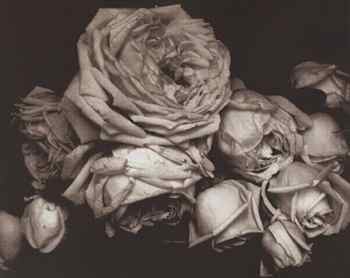
(above: Edward Steichen, Heavy Roses, Voulangis, France,
1914, photogravure, collection Museum of Photographic Arts. © Joanna
T. Steichen)
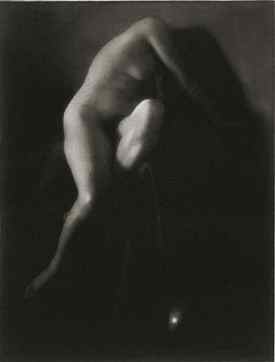
(above: Edward Steichen, Torso, Paris, 1902, photogravure,
collection Museum of Photographic Arts)
Checklist for the exhibition
- Edward Steichen (American, 1879-1973)
- Grand Prix at Longchamp: After the Races, Paris, 1907, printed
later
- From the portfolio The Early Years, 1900-1927
- Photogravure
- Museum purchase, 1985.023.001
-
- Edward Steichen (American, 1879-1973)
- Self-Portrait with Sister, Milwaukee, 1900, printed later
- From the portfolio The Early Years, 1900-1927
- Photogravure
- Museum purchase, 1985.023.002
-
- Edward Steichen (American, 1879-1973)
- Torso, Paris, 1902, printed later
- From the portfolio The Early Years, 1900-1927
- Photogravure
- Museum purchase, 1985.023.003
-
- Edward Steichen (American, 1879-1973)
- Moonrise, Mamaroneck, New York, 1904, printed later
- From the portfolio The Early Years, 1900-1927
- Photogravure
- Museum purchase, 1985.023.004
-
- Edward Steichen (American, 1879-1973)
- In Memoriam, New York, 1902, printed later
- From the portfolio The Early Years, 1900-1927
- Photogravure
- Museum purchase, 1985.023.005
-
- Edward Steichen (American, 1879-1973)
- Steichen and Wife Clara on their Honeymoon,
- Lake George, New York, 1903, printed later
- From the portfolio The Early Years, 1900-1927
- Photogravure
- Museum purchase, 1985.023.006
-
- Edward Steichen (American, 1879-1973)
- Richard Strauss, New York, 1904, printed later
- From the portfolio The Early Years, 1900-1927
- Photogravure
- Museum purchase, 1985.023.007
-
- Edward Steichen (American, 1879-1973)
- The Flatiron Building, New York, 1905, printed later
- From the portfolio The Early Years, 1900-1927
- Photogravure
- Museum purchase, 1985.023.008
-
- Edward Steichen (American, 1879-1973)
- Heavy Roses, Voulangis, France, 1914, printed later
- From the portfolio The Early Years, 1900-1927
- Photogravure
- Museum purchase, 1985.023.009
-
- Edward Steichen (American, 1879-1973)
- Isadora Duncan at the Portal of the Parthenon, Athens, 1920,
printed later
- From the portfolio The Early Years, 1900-1927
- Photogravure
- Museum purchase, 1985.023.010
-
- Edward Steichen (American, 1879-1973)
- Three Pears and an Apple, France, 1921, printed later
- From the portfolio The Early Years, 1900-1927
- Photogravure
- Museum purchase, 1985.023.011
-
- Edward Steichen (American, 1879-1973)
- Brancusi in His Studio, Paris, 1925, printed later
- From the portfolio The Early Years, 1900-1927
- Photogravure
- Museum purchase, 1985.023.012
-
- Edward Steichen (American, 1879-1973)
- Portrait of Clarence H. White, 1905, printed later
- Photogravure
- Gift of Dorothy and Eugene Prakapas, 1991.007.001
-
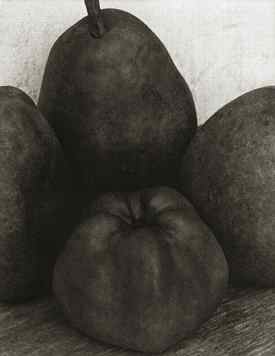
(above: Edward Steichen, Three Pears and an Apple, France,
1921, photogravure, collection Museum of Photographic Arts)
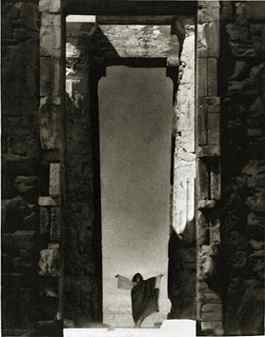
(above: Edward Steichen, Isadora Duncan at the Portal
of the Parthenon, Athens, 1920, photogravure, collection Museum of Photographic
Arts)
Resource Library readers may
also enjoy:
Read more articles and essays concerning this institutional
source by visiting the sub-index page for the Museum
of Photographic Arts in Resource Library.
Search Resource
Library for thousands of articles and essays on American art.
Copyright 2009 Traditional Fine Arts Organization, Inc., an Arizona nonprofit corporation. All rights
reserved.
 Edward Steichen (1879-1973) was one of the most influential
figures in the history of photography. MoPA celebrates this amazing talent
by exhibiting thirteen images made between 1900 and 1925, several of them
made when the photographer was still in his twenties. These early photographs
caught the attention of photographer-impresario Alfred Stieglitz and the
praise of sculptor, Auguste Rodin. (right: Edward Steichen, Grand
Prix at Longchamp: After the Races, Paris, 1907, photogravure, collection
Museum of Photographic Arts)
Edward Steichen (1879-1973) was one of the most influential
figures in the history of photography. MoPA celebrates this amazing talent
by exhibiting thirteen images made between 1900 and 1925, several of them
made when the photographer was still in his twenties. These early photographs
caught the attention of photographer-impresario Alfred Stieglitz and the
praise of sculptor, Auguste Rodin. (right: Edward Steichen, Grand
Prix at Longchamp: After the Races, Paris, 1907, photogravure, collection
Museum of Photographic Arts)




